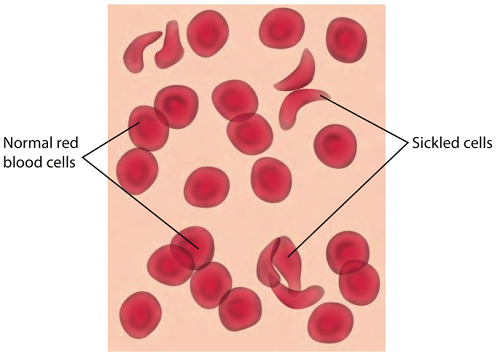- 签证留学 |
- 笔译 |
- 口译
- 求职 |
- 日/韩语 |
- 德语
Sickle-Cell Anemia
Sickle-cell anemia, also called sickle-cell disease, is a hereditary disorder in which abnormal hemoglobin within the red blood cells (RBCs) causes the cells to take on abnormal sickle (crescent) shapes. This shape decreases the ability of the hemoglobin to transport oxygen throughout the body. The sickled cells tend to bunch up and clog the blood vessels, and they tend to break apart more easily than normal RBCs, which may cause inflammation, pain, tissue damage, and anemia.
What Are the Sickle-Cell Trait and Sickle-Cell Disease?
Normally, red blood cells (RBCs) are round and flat, like a saucer. They pass easily through the tiniest blood vessels. Red blood cells sickle or take on the crescent shape when they carry an abnormal form of hemoglobin called hemoglobin S. The abnormality in hemoglobin S occurs due to the presence of a faulty gene.
People inherit one set of genes from each parent. They can inherit either two normal hemoglobin genes (HbA), one normal hemoglobin gene and one gene for the abnormal hemoglobin gene (HbS), or two abnormal HS genes, depending on the composition of their parents' genes.
When a person carries one HbS and one HbA gene, the presence of the normal gene is sufficient to override the effects of the HbS gene so the symptoms of sickle-cell disease do not develop. These people, however, are said to have the sickle-cell trait or to be carriers of the sickle-cell trait, and they may pass it on to their children. Prospective parents who are likely to carry the HbS gene may wish to be tested for its presence and receive genetic counseling before having children.

fig 1
The shape of sickled red blood cells compared to normal red blood cells.
Illustration by Frank Forney. Reproduced by permission of Gale, a part of Cengage Learning.
When people inherit two abnormal HS genes, one from each parent, they have sickle-cell disease, and they show symptoms of that disease. They have only abnormal HbS genes to pass on to their children.
Sickle-cell disease is a genetic disorder, and its frequency varies in different populations worldwide. It is found most frequently in Africa, where in some locations up to 40 percent of the population has at least one HbS gene. The gene is also found in people in Mediterranean and Middle Eastern countries, such as Italy, Greece, and Saudi Arabia. There are groups of people in India, Latin America, the Caribbean, and the United States in which the HbS gene is also found.
Among people of African ancestry in the United States, about 8 in every 100 individuals carries at least one HbS gene (has the sickle-cell trait) and about 40,000 people carry two copies of the HbS gene and have sickle-cell disease.
What Are the Effects of Sickle-Cell Disease?
People who have sickle-cell disease get infections more frequently than other people. In 1987 the National Institutes of Health recommended that all babies, regardless of ethnic or racial background, be tested at birth for the presence of the HbS. Babies with sickle-cell disease are often given antibiotics to prevent infections. Before this screening became common, many babies born with sickle-cell disease died in infancy. Later the use of preventive antibiotics significantly reduced the number of babies who died.
Infants, older children, and adults with sickle-cell disease periodically experience bouts of critical illness called crises. They also suffer from complications of anemia.
Because sickle-cell disease is hereditary, people are born with it and will have it all their lives. There is no way one person can catch sickle-cell disease or sickle-cell trait from another person, and there is no way the disease can be cured.
